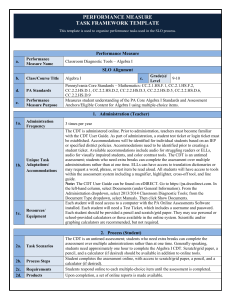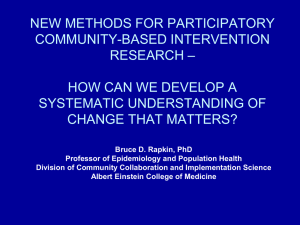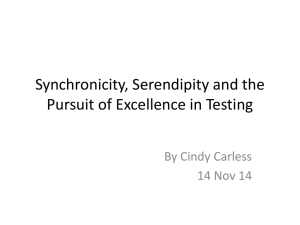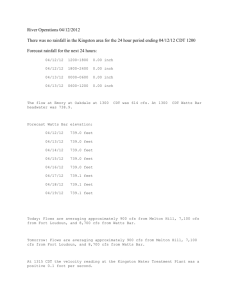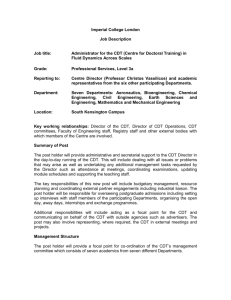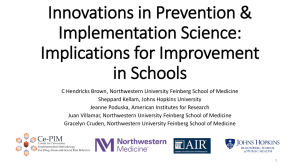Abstract - BioMed Central
advertisement
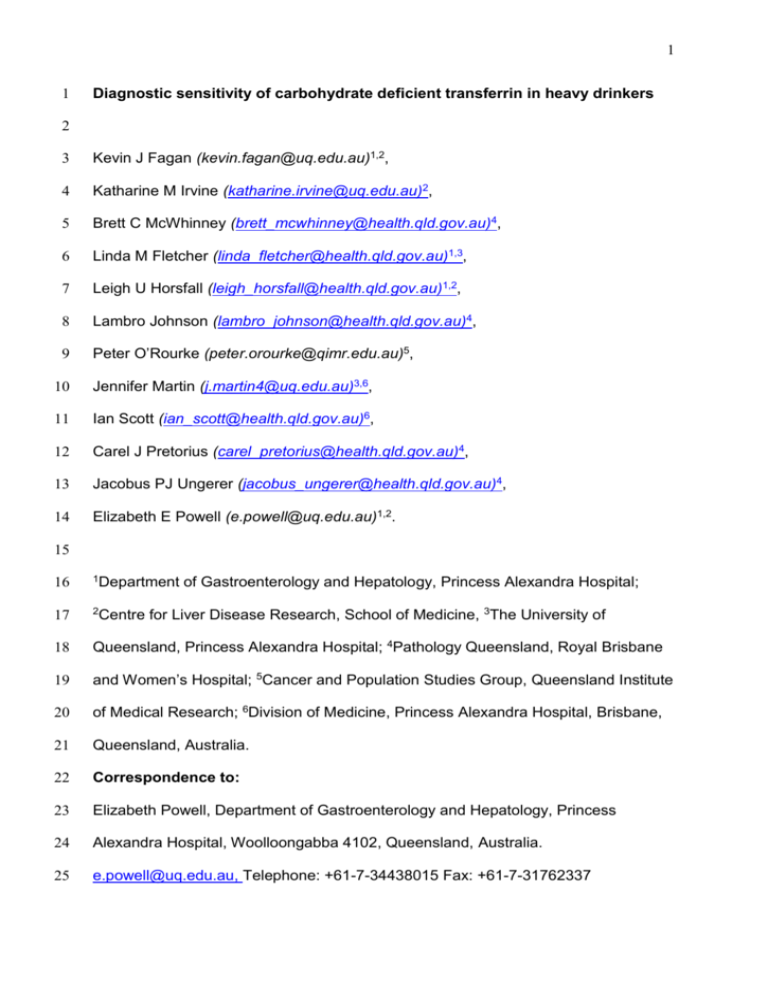
1 1 Diagnostic sensitivity of carbohydrate deficient transferrin in heavy drinkers 2 3 Kevin J Fagan (kevin.fagan@uq.edu.au)1,2, 4 Katharine M Irvine (katharine.irvine@uq.edu.au)2, 5 Brett C McWhinney (brett_mcwhinney@health.qld.gov.au)4, 6 Linda M Fletcher (linda_fletcher@health.qld.gov.au)1,3, 7 Leigh U Horsfall (leigh_horsfall@health.qld.gov.au)1,2, 8 Lambro Johnson (lambro_johnson@health.qld.gov.au)4, 9 Peter O’Rourke (peter.orourke@qimr.edu.au)5, 10 Jennifer Martin (j.martin4@uq.edu.au)3,6, 11 Ian Scott (ian_scott@health.qld.gov.au)6, 12 Carel J Pretorius (carel_pretorius@health.qld.gov.au)4, 13 Jacobus PJ Ungerer (jacobus_ungerer@health.qld.gov.au)4, 14 Elizabeth E Powell (e.powell@uq.edu.au)1,2. 15 16 1Department 17 2Centre 18 Queensland, Princess Alexandra Hospital; 4Pathology Queensland, Royal Brisbane 19 and Women’s Hospital; 5Cancer and Population Studies Group, Queensland Institute 20 of Medical Research; 6Division of Medicine, Princess Alexandra Hospital, Brisbane, 21 Queensland, Australia. 22 Correspondence to: 23 Elizabeth Powell, Department of Gastroenterology and Hepatology, Princess 24 Alexandra Hospital, Woolloongabba 4102, Queensland, Australia. 25 e.powell@uq.edu.au, Telephone: +61-7-34438015 Fax: +61-7-31762337 of Gastroenterology and Hepatology, Princess Alexandra Hospital; for Liver Disease Research, School of Medicine, 3The University of 2 26 Abstract 27 Background and Aim: Carbohydrate deficient transferrin (CDT) is the most specific 28 serum biomarker of heavy alcohol consumption, defined as ≥350–420g 29 alcohol/week. Despite introduction of a standardized reference measurement 30 technique, widespread use of CDT remains limited due to low sensitivity. The aim of 31 this study was to determine the factors that affect diagnostic sensitivity in patients 32 with sustained heavy alcohol intake. 33 Methods: Patients with a self-reported history of sustained heavy alcohol 34 consumption were recruited from the hepatology outpatient department or medical 35 wards. Each patient was interviewed with a validated structured questionnaire of 36 alcohol consumption and CDT analysis using the standardized reference 37 measurement technique with high performance liquid chromatography was 38 performed on serum collected at time of interview. 39 Results: 52 patients were recruited: 19 from the hepatology outpatient department 40 and 33 from general medical wards. Median alcohol intake was 1013 (range 366- 41 5880) g/week over the preceding two week period. 26 patients had a diagnostic CDT 42 based on a threshold value of %CDT >1.7 indicating heavy alcohol consumption, 43 yielding a sensitivity of 50%. Overweight/obesity (defined as body mass index (BMI) 44 ≥25 kg/m2 in Caucasians and ≥23.0 kg/m2 in Asians), female gender and presence 45 of cirrhosis were independently associated with non-diagnostic %CDT (≤1.7). 46 Conclusions: CDT has limited sensitivity as a biomarker of heavy alcohol 47 consumption. Caution should be applied when ordering and interpreting %CDT 48 results, particularly in women, patients with cirrhosis and those with an elevated BMI. 49 Key words/phrases: alcohol, high performance liquid chromatography, cirrhosis, 50 biomarker, obesity 51 3 52 Introduction 53 The relative amount of serum carbohydrate-deficient transferrin (CDT) is currently 54 the most specific serum biomarker of heavy alcohol consumption.[1] CDT refers to a 55 temporary alteration in the glycosylation pattern of transferrin resulting in an increase 56 in the relative amounts of disialo- and asialo-transferrin (and a decrease in 57 tetrasialotransferrin) that occurs as a result of sustained heavy alcohol consumption 58 (thresholds range from 50-80g of alcohol/day for at least 2 weeks). Altered 59 transferrin glycosylation patterns return to baseline levels within 2 to 5 weeks 60 following complete abstinence from alcohol.[2] Using the standardized reference 61 measurement technique with high performance liquid chromatography (HPLC) and 62 quantification of disialotransferrin as a percentage of total transferrin (%CDT), a 63 value of >1.7 is considered to be specific for sustained heavy alcohol consumption.[3] 64 Very few circumstances are associated with “false-positive” %CDT results using 65 HPLC. These include genetic transferrin variants,[4] rare congenital disorders of 66 glycosylation[5] and pregnancy.[6, 7] 67 68 In contrast to the high specificity, diagnostic sensitivity of %CDT for detection of 69 heavy alcohol intake is low. Previous studies using older methods of CDT analysis 70 such as immunoassays and anion-exchange methods have identified several patient 71 characteristics that affect diagnostic sensitivity.[8-13] These characteristics include 72 gender and metabolic risk factors such as obesity, insulin resistance, hypertension 73 and dyslipidemia. We recently examined the diagnostic utility of %CDT in a 74 hepatology outpatient setting.[14] Although few patients reported heavy alcohol 75 consumption at the time of study, those acknowledged heavy drinkers with a body 76 mass index (BMI) in the overweight or obese range had significantly lower %CDT 4 77 values than lean heavy drinkers.[14] Neither the presence of compensated chronic 78 liver disease, nor the etiology of non-alcoholic liver disease influenced interpretation 79 of the CDT results. A key limitation of our earlier study and other previous studies 80 investigating %CDT is the inclusion of patients with a broad range of alcohol intake 81 and a relatively small proportion of patients with a heavy alcohol intake, at a level 82 expected to cause %CDT >1.7. 83 84 Despite recognition that clinical history and self-report screening tests are efficient 85 methods to identify at-risk patients, there is clearly a need for an objective biomarker 86 to support clinical suspicion of heavy alcohol intake. In order to improve the clinical 87 utility of CDT measurements, factors that affect the diagnostic sensitivity and 88 specificity need to be clearly defined, so that the test is requested and interpreted 89 appropriately. The aim of this study was to determine in patients with sustained 90 heavy alcohol intake, whether the level of %CDT is influenced by BMI or other 91 clinical variables such as gender, age, ethnicity and smoking. To our knowledge, 92 this is the first time that these factors have been examined in a cohort of patients 93 with sustained heavy alcohol consumption. 94 95 Materials and Methods 96 Patients and clinical data 97 Patients with self-reported heavy alcohol consumption were recruited from the 98 hepatology outpatient department or medical wards at the Princess Alexandra 99 Hospital, Brisbane, Australia during 2012 and 2013. Informed consent was obtained 100 from each patient and the protocol was approved by Metro-South-Health and the 101 University of Queensland Human Research Ethics Committees. Those who agreed 5 102 to participate were interviewed by the research co-ordinator using a structured 103 questionnaire and a standard drink guide. 104 105 The questionnaire included an alcohol calendar to record alcohol consumption over 106 the prior 4-week period and further direct questions to determine whether the 107 calendar reflected usual alcohol consumption. It also recorded any previous periods 108 of heavy alcohol consumption, defined as ≥350g/week for females and ≥420g/week 109 for males for ≥6 months. These questions were supplemented by validated alcohol 110 screening tools; the Alcohol Use Disorders Identification Test (AUDIT)[15] and the 111 Brief Michigan Alcoholism Screening Test (BMAST),[16] to confirm current heavy 112 alcohol consumption (as previously defined) and identify alcohol dependence. 113 114 Measurements of weight and height were obtained from patients at the time of 115 interview. BMI was calculated as weight in kg/(height in meters)2. BMI was classified 116 as lean (<25 kg/m2 in Caucasians, <23 kg/m2 in Asians), overweight (25-29.9 kg/m2 117 in Caucasians, 23.0 to 24.9 kg/m2 in Asians) or obese (≥30 kg/m2 in Caucasians, ≥ 118 25.0kg/m2 in Asians). Lean body weight (LBW) was calculated using the 119 Janmahasatian equation, as this has been validated in an obese population,[17] and 120 then used to estimate the volume of distribution (Vd) of alcohol, since fat has little 121 water. 122 123 The medical record was reviewed to ascertain demographic details, previously 124 diagnosed liver disease and other medical conditions, medications and history of 125 alcohol, tobacco and recreational drug use. Standard biochemical and serological 126 assays, liver imaging and histological assessment of a liver biopsy (if performed) 6 127 were used to assess diagnosis and etiology of liver disease. In the absence of a liver 128 biopsy, cirrhosis was determined on the basis of a Fibroscan® result >14 kPa and/or 129 liver imaging (nodular or irregular liver surface and/or features of portal hypertension) 130 in conjunction with other clinical and/or biochemical parameters. The severity of liver 131 disease was evaluated using the Child-Turcotte-Pugh (CTP) classification. All 132 patients with chronic hepatitis C had detection of circulating HCV RNA by 133 polymerase chain reaction using the Abbott m2000 RealTime System (Abbott 134 Laboratories, Illinois, USA). Routine haematological and biochemical tests were 135 performed within 1-3 days of interview and serum collection for CDT analysis. 136 137 CDT analysis 138 Serum was collected at the time of interview and stored at -80ºC, a condition under 139 which the transferrin isoform pattern is stable.[18] CDT analysis was performed on a 140 Waters HPLC System (Waters Corporation Milford MA USA) as previously 141 described.[14] The currently accepted laboratory reference value indicative of heavy 142 drinking is %CDT >1.7.[3] 143 144 Statistical Methods 145 Statistical analyses were performed in SPSS, employing Fisher’s exact test for 146 categorical variables, either t-test or Mann-Whitney U-test for continuous variables 147 and Spearman correlation analysis for univariate tests. Logistic regression with 148 backward elimination of non-significant terms was used for multivariate models. A p- 149 value of <0.05 was considered statistically significant. 150 151 Results 7 152 Patient characteristics 153 Overall, 19 patients were recruited from the hepatology outpatient department and 154 33 were approached within 48 hours of admission to a general medical ward. All 52 155 patients reported previous periods of heavy alcohol consumption and excessive 156 alcohol use during the 4 weeks prior to interview, with a median intake of 1013 157 (range 366-5880) g/week over the preceding 2 week period. In the general medicine 158 group, the reason for presentation was: alcohol intoxication/withdrawal symptoms 159 (n=21), alcoholic hepatitis (n=4), gastrointestinal bleed (n=3), infection (n=4) and 160 pancreatitis (n=1). Overall, the mean age of subjects was 50.3 (±11.8) years, 37 161 (71.2%) were men and 45 (86.5%) were Caucasian. BMI was lean in 27 patients 162 (51.9%), overweight in 12 (23.1%), and obese in 13 (25%). 163 164 Eighteen patients (34.6%) had cirrhosis as determined by liver biopsy or imaging and 165 15 patients had evidence of concurrent hepatitis C infection (HCV). Other chronic 166 medical conditions included: type 2 diabetes (n=6), hypertension (n=20), 167 hyperlipidaemia (n=9), rheumatoid arthritis (n=2), COPD/asthma (n=9), chronic 168 kidney disease (CKD) >stage 3 (eGFR≤59) (n=2). 169 170 Characteristics of patients with %CDT ≤ or >1.7 171 Despite all 52 patients demonstrating heavy drinking based on results of 172 questionnaires, only 26 had a %CDT >1.7. The characteristics of patients with 173 %CDT ≤ or >1.7 are detailed in Table 1. A statistically significant difference in BMI 174 was seen between heavy drinkers with a “diagnostic” or “non-diagnostic” %CDT. The 175 mean (+/- SD) BMI of heavy drinkers with %CDT >1.7 was 23.3 (+/- 3.9) kg/m2, with 176 73.1% within the lean weight range. In contrast, the mean (+/- SD) BMI for heavy 8 177 drinkers with %CDT ≤1.7 was 28.2 (+/- 7.2) kg/m2, with only 30.8% within the lean 178 weight range. Eighteen of 25 patients (72%) with BMI in the overweight/obese range 179 had %CDT ≤1.7. The two overweight/obese patients with notably raised %CDT had 180 CKD stage 3, with moderately reduced kidney function (eGFR 30-59). The presence 181 of hypertension did not differ in relation to %CDT ≤ or >1.7. Diabetes and 182 hyperlipidemia were infrequent comorbidities in this group of patients and therefore 183 their impact could not be evaluated. 184 185 Fifteen of 18 patients (83.3%) with cirrhosis had a non-diagnostic %CDT. Of these 186 15 patients, 7 had compensated disease (CTP score A), 7 had functional 187 compromise (CTP score B) and 1 had decompensated liver disease (CTP score C). 188 The 3 cirrhotic subjects with %CDT >1.7 had compensated disease (CTP score A). A 189 statistically significant difference was also seen between gender and %CDT 190 category, with women far less likely than men, to have a diagnostic %CDT. In 191 contrast, ethnicity, age, and smoking status were comparable between the %CDT 192 categories. 193 194 Median alcohol consumption over the 2 weeks prior to interview was higher for 195 patients with %CDT >1.7 (1257.5 g/week) compared to subjects with %CDT ≤1.7 196 (867.5 g/week; p<0.005). (Table 1) To consider the effects of body size and 197 composition on alcohol concentrations, alcohol consumption was corrected for 198 apparent volume of distribution (Vd) of alcohol using estimated lean body weight 199 (LBW) as a surrogate for Vd. Median alcohol consumption per estimated Vd was 200 17.3 and 24.1 g/week/kg LBW in patients with %CDT ≤ and >1.7 respectively 201 (P<0.007). (Table 1) Alcohol consumption (g/wk/kg LBW) and %CDT were 9 202 correlated, but the correlation was better for lean (rs=0.51, P<0.01) than overweight 203 subjects (rs=0.18, P=0.40), non-cirrhotic (rs=0.54, P<0.001) compared with cirrhotic 204 subjects (rs=0.02, P=0.94) and males (rs=0.48, P<0.01) compared with females 205 (rs=0.15, P=0.60) (Figure 1). 206 207 No statistically significant differences between the two groups for laboratory tests 208 commonly used in clinical practice to suggest sustained heavy alcohol use (serum 209 aminotransferases, gamma-glutamyltransferase, platelet count and mean 210 corpuscular volume) were seen. (Table 2). 211 212 Following multivariate analysis initially including age, gender, cirrhosis, BMI 213 category, alcohol consumption and smoking status, overweight/obesity (OR=5.8, 214 p=0.047), presence of cirrhosis (OR=17.2, p=0.007), female gender (OR=14.3, 215 p=0.019) and lower alcohol consumption (OR=0.998, p=0.029) remained 216 independently associated with %CDT ≤1.7. (Table 3) 217 218 Discussion 219 Although %CDT (determined by the HPLC assay) remains the most specific serum 220 biomarker of prolonged heavy alcohol consumption,[1] its widespread use in clinical 221 practice remains limited, largely due to concern about poor sensitivity and 222 uncertainty about the factors that impact on CDT response to alcohol. This study 223 was undertaken to identify clinical variables that affect the sensitivity of the 224 standardized HPLC-based CDT assay in detecting heavy drinkers. Our study shows 225 that only 50% of subjects drinking >50-60g alcohol daily for at least 2 weeks had a 226 %CDT >1.7%, indicative of heavy alcohol intake. Overweight/obesity, the presence 10 227 of cirrhosis and female gender were independently associated with a non-diagnostic 228 %CDT level (≤1.7). 229 230 Previous population-based studies measuring CDT by ion-exchange 231 chromatography and immunoassay found several patient characteristics, including 232 gender, a high BMI and an insulin-resistant phenotype (high triglycerides and low 233 HDL-cholesterol) were associated with reduced sensitivity of the CDT response to 234 alcohol.[8, 10] In contrast, more recent studies that quantified CDT using the 235 standardized HPLC method did not find any clinically significant differences in CDT 236 in relation to gender or BMI.[19] The authors concluded that the earlier findings were 237 related to the analytical techniques used for measurement of CDT, and that 238 adjustment of reference intervals in relation to gender or BMI was not required. [3, 19] 239 However, a major limitation of these studies was the low or unclear number with 240 confirmed heavy drinking. In our study involving only confirmed heavy drinkers, 241 elevated BMI and female gender clearly reduce the diagnostic sensitivity of %CDT 242 using the standardized HPLC method. 243 244 Reporting CDT as relative amount of total transferrin concentration rather than an 245 absolute value has improved sensitivity and specificity of the assay.[20] Introduction of 246 this method was expected to negate many of the factors attributed to gender (e.g. 247 pregnancy, oestrogens and anaemia), since they can cause variations in total 248 transferrin concentrations. However, recent reports using %CDT have demonstrated 249 that gender differences[21] and pregnancy-related changes in CDT isoform levels 250 occur, although no biologic mechanism has been described.[7, 22] Women may differ 11 251 in the CDT isoforms that are increased by heavy alcohol intake, such as asialo- and 252 monosialotransferrin,[23] neither of which are included in %CDT measurement using 253 the new standardised HPLC technique. This would be in keeping with previous 254 findings that women express higher CDT levels under basal conditions, but produce 255 less in response to heavy drinking.[24, 25] 256 257 We previously investigated the diagnostic utility of %CDT in patients with liver 258 disease, and found that heavy drinkers with a BMI in the overweight or obese range 259 had significantly lower %CDT values than lean heavy drinkers.[14] The current study 260 extends these findings by confirming the results in a larger group of subjects with 261 confirmed heavy alcohol consumption and by showing that the effect of BMI is 262 independent of other clinical variables. Interestingly 2 subjects had markedly 263 elevated %CDT values (9.68% and 12.55%) despite overweight/obesity, in the 264 setting of moderately decreased renal function (eGFR 30-59). Currently little is 265 known regarding the process and elimination kinetics of CDT from the circulation and 266 thus the mechanisms responsible for this effect are unclear, but may relate to altered 267 elimination in the presence of renal failure.[26] Chronic kidney disease does not 268 appear to cause an increase in the baseline levels of CDT in subjects without 269 hazardous drinking.[27] Similarly, non-enzymatic glycation of transferrin, a process 270 that may occur in uremia[26] and diabetic subjects[28] does not appear to interfere with 271 HPLC-based CDT measurement.[29] 272 273 In our prior study we found that the presence of cirrhosis due to various chronic liver 274 diseases did not lead to “false positive” %CDT results.[14] In the current study of 275 heavy drinkers, cirrhosis was associated with reduced sensitivity of the %CDT 12 276 response to alcohol, which is contrary to some previous reports.[30-32] This finding 277 confirms earlier studies using non-HPLC methods that found patients with cirrhosis 278 and a high current alcohol intake had lower CDT values compared with “control” 279 subjects without liver disease but drinking more than 50g alcohol/day.[33] The 280 reasons underlying these findings remain unclear. Transferrin is synthesised, 281 glycosylated and secreted by the liver and the rate of transferrin synthesis is reduced 282 in cirrhotic patients.[34] Furthermore insulin resistance is present in nearly all patients 283 with cirrhosis[35] and thus similar mechanisms may reduce the CDT response to 284 alcohol in the setting of cirrhosis and overweight/obesity. 285 286 In conclusion, %CDT has limited sensitivity as an objective biomarker to identify 287 subjects consuming harmful amounts of alcohol. In our cohort of sustained heavy 288 drinkers, diagnostic sensitivity of %CDT was 50% and yielded false negative results 289 in particular patient subgroups: women, patients with cirrhosis and those with an 290 elevated BMI. Therefore caution should be applied when ordering and interpreting 291 %CDT results in these subject populations. Further studies with larger numbers of 292 well-characterised patients, who consume heavy amounts of alcohol, are required to 293 further assess factors which impact on the sensitivity of this assay. 294 295 296 297 298 299 300 13 301 Competing Interests: 302 The authors declare that they have no competing interests. 303 304 Authors Contribution: 305 KF conceived and coordinated the study, collected patient data and blood samples, 306 contributed to analysis of data and wrote the manuscript. KI contributed to analysis 307 of data and writing the manuscript. LH collected patient data and blood samples and 308 contributed to the manuscript. BM, LJ, JU, CP performed the CDT analysis and 309 contributed to data analysis and writing the manuscript. PO performed the statistical 310 analysis and contributed to the manuscript. LF, JM and IS contributed to data 311 analysis and writing the manuscript. EP conceived the study and contributed to 312 analysis of data and writing the manuscript. All authors read and approved the final 313 manuscript. 314 315 316 317 Acknowledgements: 318 This study was funded by the National Health and Medical Research Council of 319 Australia, The Queensland Government’s Smart State Health and Medical Research 320 Fund, The Princess Alexandra Hospital Research and Development Foundation and 321 the Australian Liver Foundation. 322 323 324 325 14 326 Abbreviations 327 CDT Carbohydrate deficient transferrin 328 BMI Body mass index 329 HPLC High performance liquid chromatography 330 AUDIT Alcohol Use Disorders Identification Test 331 BMAST Brief Michigan Alcoholism Screening Test 332 LBW Lean body weight 333 Vd Volume of distribution 334 CTP Child-Turcotte-Pugh 335 CKD Chronic kidney disease 336 OR Odds ratio 337 SPSS Statistical package for the social sciences 338 SD Standard deviation 339 HCV Hepatitis C virus 340 341 342 343 344 345 346 15 347 References 348 1. Helander A, Wielders JPM, Jeppsson JO, Weykamp C, Siebelder C, Anton 349 RF, Schellenberg F, Whitfield JB. Toward standardization of carbohydrate- 350 deficient transferrin (CDT) measurements: II. Performance of a 351 laboratory network running the HPLC candidate reference measurement 352 procedure and evaluation of a candidate reference material. Clinical 353 Chemistry and Laboratory Medicine 2010, 48(11):1585-1592. 354 2. Anton RF, Lieber C, Tabakoff B. Carbohydrate-deficient transferrin and 355 gamma-glutamyltransferase for the detection and monitoring of alcohol 356 use: Results from a multisite study. Alcoholism-Clinical and Experimental 357 Research 2002, 26(8):1215-1222. 358 3. Bergstrom JP, Helander A. Clinical characteristics of carbohydrate- 359 deficient transferrin (%disialotransferrin) measured by HPLC: 360 Sensitivity, specificity, gender effects, and relationship with other 361 alcohol biomarkers. Alcohol and Alcoholism 2008, 43(4):436-441. 362 4. Helander A, Eriksson G, Stibler H, Jeppsson JO. Interference of transferrin 363 isoform types with carbohydrate-deficient transferrin quantification in 364 the identification of alcohol abuse. Clin Chem 2001, 47(7):1225-1233. 365 5. Helander A, Bergstrom J, Freeze HH. Testing for congenital disorders of 366 glycosylation by HPLC measurement of serum transferrin glycoforms. 367 Clin Chem 2004, 50(5):954-958. 368 6. Bianchi V, Ivaldi A, Raspagni A, Arfini C, Vidali M. Pregnancy and variations 369 of carbohydrate-deficient transferrin levels measured by the candidate 370 reference HPLC method. Alcohol Alcohol 2011, 46(2):123-127. 16 371 7. Kenan N, Larsson A, Axelsson O, Helander A. Changes in transferrin 372 glycosylation during pregnancy may lead to false-positive carbohydrate- 373 deficient transferrin (CDT) results in testing for riskful alcohol 374 consumption. Clin Chim Acta 2011, 412(1-2):129-133. 375 8. Whitfield JB, Dy V, Madden PA, Heath AC, Martin NG, Montgomery GW. 376 Measuring carbohydrate-deficient transferrin by direct immunoassay: 377 factors affecting diagnostic sensitivity for excessive alcohol intake. Clin 378 Chem 2008, 54(7):1158-1165. 379 9. Fagerberg B, Agewall S, Urbanavicius V, Attvall S, Lundberg PA, Lindstedt G. 380 Carbohydrate-deficient transferrin is associated with insulin sensitivity 381 in hypertensive men. Journal of Clinical Endocrinology & Metabolism 1994, 382 79(3):712-715. 383 10. Whitfield JB, Fletcher LM, Murphy TL, Powell LW, Halliday J, Heath AC, 384 Martin NG. Smoking, obesity, and hypertension alter the dose-response 385 curve and test sensitivity of carbohydrate-deficient transferrin as a 386 marker of alcohol intake. Clin Chem 1998, 44(12):2480-2489. 387 11. Arndt T, Hackler R, Muller T, Kleine TO, Gressner AM. Increased serum 388 concentration of carbohydrate-deficient transferrin in patients with 389 combined pancreas and kidney transplantation. Clin Chem 1997, 390 43(2):344-351. 391 12. Szegedi A, Muller MJ, Himmerich H, Anghelescu I, Wetzel H. Carbohydrate- 392 deficient transferrin (CDT) and HDL cholesterol (HDL) are highly 393 correlated in male alcohol dependent patients. Alcohol Clin Exp Res 2000, 394 24(4):497-500. 17 395 13. Brathen G, Bjerve KS, Brodtkorb E, Helde G, Bovim G. Detection of alcohol 396 abuse in neurological patients: variables of clinical relevance to the 397 accuracy of the %CDT-TIA and CDTect methods. Alcohol Clin Exp Res 398 2001, 25(1):46-53. 399 14. Fagan KJ, Irvine KM, McWhinney BC, Fletcher LM, Horsfall LU, Johnson LA, 400 Clouston AD, Jonsson JR, O'Rourke P, Martin J, Pretorius CJ, Ungerer JP, 401 Powell EE. BMI But Not Stage or Etiology of Nonalcoholic Liver Disease 402 Affects the Diagnostic Utility of Carbohydrate-Deficient Transferrin. 403 Alcohol Clin Exp Res 2013, 37(10):1771-1778. 404 15. Saunders JB, Aasland OG, Babor TF, De la Fuente JR, Grant M. 405 Development of the Alcohol Use Disorders Identification Test (AUDIT): 406 WHO Collaborative Project on Early Detection of Persons with Harmful 407 Alcohol Consumption--II. Addiction 1993, 88(6):791-804. 408 16. Pokorny AD, Miller BA, Kaplan HB. The brief MAST: a shortened version of 409 the Michigan Alcoholism Screening Test. Am J Psychiatry 1972, 410 129(3):342-345. 411 17. Janmahasatian S, Duffull SB, Ash S, Ward LC, Byrne NM, Green B. 412 Quantification of lean bodyweight. Clin Pharmacokinet 2005, 44(10):1051- 413 1065. 414 18. of carbohydrate-deficient transferrin. Clin Chem 1998, 44(10):2226-2227. 415 416 Martensson O, Schink E, Brandt R. Diurnal variability and in vitro stability 19. Bergstrom JP, Helander A. Influence of alcohol use, ethnicity, age, 417 gender, BMI and smoking on the serum transferrin glycoform pattern: 418 Implications for use of carbohydrate-deficient transferrin (CDT) as 419 alcohol biomarker. Clinica Chimica Acta 2008, 388(1-2):59-67. 18 420 20. Helander A. Absolute or relative measurement of carbohydrate-deficient 421 transferrin in serum? Experiences with three immunological assays. Clin 422 Chem 1999, 45(1):131-135. 423 21. Ridinger M, Kohl P, Gabele E, Wodarz N, Schmitz G, Kiefer P, Hellerbrand C. 424 Analysis of carbohydrate deficient transferrin serum levels during 425 abstinence. Exp Mol Pathol 2012, 92(1):50-53. 426 22. Bakhireva LN, Cano S, Rayburn WF, Savich RD, Leeman L, Anton RF, 427 Savage DD. Advanced gestational age increases serum carbohydrate- 428 deficient transferrin levels in abstinent pregnant women. Alcohol Alcohol 429 2012, 47(6):683-687. 430 23. Martensson O, Harlin A, Brandt R, Seppa K, Sillanaukee P. Transferrin 431 isoform distribution: gender and alcohol consumption. Alcohol Clin Exp 432 Res 1997, 21(9):1710-1715. 433 24. Anton RF, Moak DH. Carbohydrate-deficient transferrin and gamma- 434 glutamyltransferase as markers of heavy alcohol consumption: gender 435 differences. Alcohol Clin Exp Res 1994, 18(3):747-754. 436 25. Sillanaukee P, Massot N, Jousilahti P, Vartiainen E, Sundvall J, Olsson U, 437 Poikolainen K, Ponnio M, Allen JP, Alho H. Dose response of laboratory 438 markers to alcohol consumption in a general population. Am J Epidemiol 439 2000, 152(8):747-751. 440 26. Piroddi M, Depunzio I, Calabrese V, Mancuso C, Aisa CM, Binaglia L, Minelli 441 A, Butterfield AD, Galli F. Oxidatively-modified and glycated proteins as 442 candidate pro-inflammatory toxins in uremia and dialysis patients. 443 Amino Acids 2007, 32(4):573-592. 19 444 27. Wolff F, Mesquita M, Corazza F, Demulder A, Willems D. False positive 445 carbohydrate-deficient transferrin results in chronic hemodialysis 446 patients related to the analytical methodology. Clin Biochem 2010, 43(13- 447 14):1148-1151. 448 28. Van CA, Van CC, Olyslager YS, Van DO, Lagrou AR, Manuel-y-Keenoy B. A 449 novel method to quantify in vivo transferrin glycation: applications in 450 diabetes mellitus. Clin Chim Acta 2006, 370(1-2):115-123. 451 29. Helander A, Kenan MN. Effect of transferrin glycation on the use of 452 carbohydrate-deficient transferrin as an alcohol biomarker. Alcohol 453 Alcohol 2013, 48(4):478-482. 454 30. DiMartini A, Day N, Lane T, Beisler AT, Dew MA, Anton R. Carbohydrate 455 deficient transferrin in abstaining patients with end-stage liver disease. 456 Alcohol Clin Exp Res 2001, 25(12):1729-1733. 457 31. Stewart SH, Comte-Walters S, Bowen E, Anton RF. Liver Disease and 458 HPLC Quantification of Disialotransferrin for Heavy Alcohol Use: A Case 459 Series. Alcoholism-Clinical and Experimental Research 2010, 34(11):1956- 460 1960. 461 32. Arndt T, van der Meijden BB, Wielders JPM. Atypical serum transferrin 462 isoform distribution in liver cirrhosis studied by HPLC, capillary 463 electrophoresis and transferrin genotyping. Clinica Chimica Acta 2008, 464 394(1-2):42-46. 465 33. Henriksen JH, Gronbaek M, Moller S, Bendtsen F, Becker U. Carbohydrate 466 deficient transferrin (CDT) in alcoholic cirrhosis: a kinetic study. J 467 Hepatol 1997, 26(2):287-292. 20 468 34. metabolism in alcoholic liver disease. Hepatology 1985, 5(5):714-721. 469 470 Potter BJ, Chapman RW, Nunes RM, Sorrentino D, Sherlock S. Transferrin 35. Petrides AS, Stanley T, Matthews DE, Vogt C, Bush AJ, Lambeth H. Insulin 471 resistance in cirrhosis: prolonged reduction of hyperinsulinemia 472 normalizes insulin sensitivity. Hepatology 1998, 28(1):141-149. 473 474 475 21 476 Figure Legends 477 Figure 1: Correlation of alcohol consumption (g/wk/kg LBW) and %CDT for: (A) lean 478 vs. overweight/obese subjects; (B) non cirrhotic vs. cirrhotic subjects; and (C) men 479 vs. women. (# identifies the 2 patients with moderately decreased renal function 480 (eGFR 30-59)). (LBW = Lean body weight). 481 482 483 484 485 486 487 488 489 490 491 492 493 494 495 496 497 498 499 22 500 Table 1: Demographic and clinical details of patients in relation to the %CDT 501 reference cut-off value of 1.7. P%CDT ≤1.7 %CDT >1.7 value Subjects (n) 26 26 22 (84.6) 23 (88.5) 1.00 51.1 (±10.2) 49.6 (±13.3) 0.67 13 (50.0) 24 (92.3) 0.002 28.2 (±7.2) 23.3 (±3.9) 0.003 14 (53.8) 20 (76.9) 0.14 868 1258 (366-2100) (510-5880) 17.3 24.1 (g/week/kg) (range) (6.7-42.2) (7.4-82.5) 0.007 AUDIT mean (± SD) 27.6 (±7.2) 28.7 (±6.9) 0.57 BMAST mean (± SD) 17.6 (±8.1) 22.5 (±6.2) 0.018 15 (57.7) 3 (11.5) 0.001 Caucasian (n, %) Age (years) mean (± SD) Gender (n, % men) BMI (kg/m2) mean (± SD) Smoker (n, %) Median alcohol consumption last 2 weeks (g/week) (range) Median estimated alcohol/Vd Cirrhosis (n, %) 502 503 504 505 506 507 508 0.005 23 509 Table 2: Selected laboratory data of patients in relation to the %CDT reference cut- 510 off value of 1.7. Laboratory Test, median Normal P%CDT ≤1.7 (IQR) %CDT >1.7 Range Alkaline phosphatase (U/L) value 101.5 90.5 (79.3-157.8) (74.3-105.8) 182.0 135.5 (119.0-469.0) (46.3-274.5) 54.0 57.5 (30.0-74.3) (28.5-88.3) 100.0 76.0 (58.3-158.0) (48.3-130.8) 165.5 168 (97.3-208.8) (136.8-207.8) 98.5 96.5 (96.0-100.8) (91.3-100.0) 53-128 Gammaglutamyl transferase 0.073 <55 (U/L) Alanine transaminase (U/L) Aspartate transaminase (U/L) Platelets (x 109/L) Mean cell volume (fL) 511 512 513 514 515 516 517 518 519 0.13 <45 0.50 <35 0.68 140-400 0.42 80-100 0.084 24 520 Table 3: Variables independently associated with a non-diagnostic %CDT identified 521 by logistic regression. For categorical variables, the odds ratio refers to the category 522 shown in brackets; for alcohol consumption the odds ratio refers to the decreased 523 likelihood of a non-diagnostic %CDT per increase in alcohol consumption by 524 1g/week. 95% Confidence Intervals Odds P- Variable Ratio Lower Upper value Gender (Women) 14.3 1.5 132.0 0.019 BMI (Overweight/Obese) 5.8 1.0 32.9 0.047 Cirrhosis (Yes) 17.2 2.2 137.0 0.007 0.998 0.996 1.000 0.029 Alcohol consumption over prior 2 weeks (g/week) 525 526
